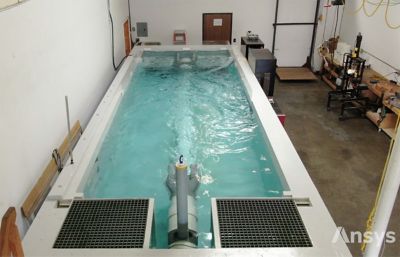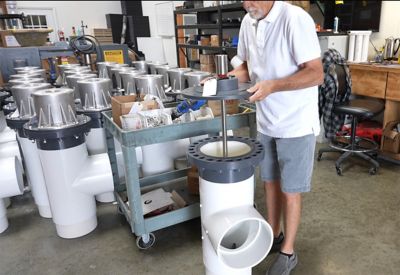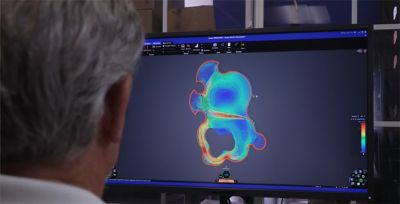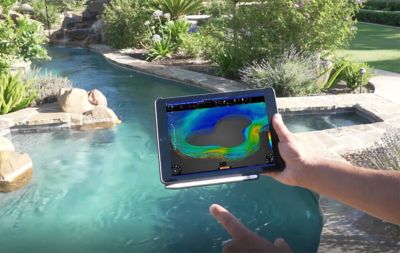-
-
Access Free Student Software
Ansys empowers the next generation of engineers
Students get free access to world-class simulation software.
-
Connect with Ansys Now!
Design your future
Connect with Ansys to explore how simulation can power your next breakthrough.
Countries & Regions
Free Trials
Products & Services
Learn
About
Back
Products & Services
Back
Learn
Ansys empowers the next generation of engineers
Students get free access to world-class simulation software.
Back
About
Design your future
Connect with Ansys to explore how simulation can power your next breakthrough.
Free Trials
ANSYS BLOG
October 13, 2022
Making a Splash: Current Systems Uses Ansys Discovery to Demonstrate Its Aquatic Innovations
Founded in 2002, Current Systems is a leader in manufacturing axial flow pumps, suction sumps, propulsion nozzles, and other components for counter-current swimming and “lazy river” applications. The California-based company also consults on the design and engineering of large-scale aquatic features for water parks, resorts, and luxury residences.
“I’ve been intrigued by water and its flow patterns since I served on an aircraft carrier in the 1960s,” explains founder Peter Davidson. “Water in motion is compelling. Millions of people flock to oceans and rivers every year to enjoy these phenomena. My goal and pleasure is to provide the moving water experience to folks in a controlled environment. That’s why I founded Current Systems — and why I’m so passionate about the integration of current with aquatic environments.”
Greecian Pools out of Bakersfield, California, partners with Current Systems Inc., using their Riverflow Technology for Lazy River Designs.
For years, Davidson has partnered with professional engineering firms that serve the resort and water park industries, many of whom actively use Ansys Fluent. Current Systems collaborates with these firms, using computational fluid dynamics (CFD) simulation via Fluent to verify that the aquatic designs will perform as expected once they’re constructed.
This can be a challenging task. Lazy river designs include multiple pumps, inlets, and outlets, along with bends, twists, and turns — all of which must be carefully engineered. For counter-current swimming pools, the flow pattern must be exactly matched to the pool’s unique geometry to ensure a stable, functional current.

Current Systems Inc. testing facility in Ventura, CA, where they test new pump designs.
“It’s important to get the current characteristics right in terms of volume, velocity, and direction,” Davidson notes. “A river that’s too ‘lazy’ won’t be enjoyable — and a counter-current swimming pool needs to provide just the right ‘swim in place’ experience to optimize the workout. Quickly iterating CFD simulations through a range of current speeds is particularly useful in current-pool and propulsion nozzle design.
“Our partners use Fluent to verify and optimize the final design for us,” he says. “Fluent is definitely the industry standard for studying and visualizing complex fluid phenomena like hydraulic jumps, eddying, turbulence, recirculation, and vortices. While our team has deep experience in designing water systems, Fluent has always provided us with that extra reassurance before our customer begins physical construction of a large-scale feature.”
While Davidson and his team were happy with the highly accurate results provided by Fluent, several years ago they began to wonder if they could bring CFD simulation in-house. However, since the company is small — with only 11 employees — it seemed impractical to bring a trained simulation engineer on board.

Assembly of the famous Riverflow Systems Pumps.
Diving Headfirst into In-House Simulation
Enter Ansys Discovery. A few years ago, Current Systems began using this user-friendly, intuitive solution to verify its aquatic designs in-house, applying its many years of old-school expertise to the use of CFD solutions. Discovery enables companies like Current Systems to access physics-based simulation capabilities, create high-fidelity performance models, and design interactive geometries quickly with a single tool.
The technical team at Current Systems uses Discovery to conduct limited-meshing simulations of fluid dynamics, verifying performance and identifying any issues at an early stage of design. Instead of outsourcing CFD studies, Current Systems can explore fluid dynamics and adjust customer plans in real time, instead of waiting — and paying — for the results of numerically large, computationally complex studies.
“Our team has decades of experience in applying our own pumps, nozzles, and other equipment to bring our customers’ visions to life,” Davidson points out. “We were paying up to $25,000 for expert analysis and verification for some of our projects, when there were very few, or no, issues to address in the end. Ansys Discovery has allowed us to save both time and money by bringing the verification work for many projects in-house.”

Peter Davidson, owner and CEO of Current Systems Inc., using Discovery for design exploration of inlet and outlet placement to understand flow paths and patterns.
Helping Customers Visualize the Final Result, Upfront
According to Davidson, that’s not the only significant advantage provided by Discovery. “Our business is based to a great extent on aesthetics,” he emphasizes. “Our systems can be found at some of the world’s most beautiful resorts, waterparks, and private homes. In addition to perfecting the underlying fluids engineering, we also need to create attractive shapes and geometries that keep with each customer’s brand and design aesthetic.”
With Discovery, Current Systems finally has a highly graphic, colorful, and dynamic way to show each customer the planned result, upfront — before any significant investments have been made. “It’s so valuable to be able to open a laptop and show customers a working, full-color demonstration of their river or pool design,” says Davidson. “It gets them excited. And it provides an opportunity to answer any questions and address any concerns while we’re looking at a dynamic virtual model together.
“Discovery is a powerful communications tool that has dramatically improved the way we present our ideas to our customers,” he continues. “Whether we’re presenting to a contractor, an architect, or a designer, Discovery makes complex fluid dynamics easy to visualize and understand. In real time, we can balance the customer’s aesthetic vision with practical, real-world concerns like eddying, recirculation, and hydraulic jumps. We can show them the trade-offs and make optimal decisions together. That’s never been possible before. In a single meeting, we can accomplish what used to take weeks or months.”

Grecian Pools communicating to their customer on how the flowpaths of the newly installed Riverflow System matches the results of Ansys, solidifying confidence on the new lazy river design.
Going With the Flow: Creating a Flexible Simulation Toolkit
According to Davidson, Current Systems still relies on the power of Fluent to verify its largest lazy river projects, which might span thousands of feet and include up to 40 river-flow pumps. “We have no plans to bring that kind of simulation expertise in-house; it simply doesn’t make sense from a profitability standpoint. So, we still rely on expert partners to run Fluent simulations for our very large-scale designs,” he notes.
However, for many smaller-scale projects, Current Systems can use Discovery to conduct limited-meshing simulations and quickly verify that the company’s best design practices, developed over 20 years, will deliver the expected performance under real-world conditions. Current Systems’ flexible simulation toolkit is increasing its speed-to-market, profitability, and level of innovation — a new approach that’s going swimmingly.
Interested in learning more? Watch this video to see Ansys Discovery in action at Current Systems. Learn more about how Discovery can benefit your business here.